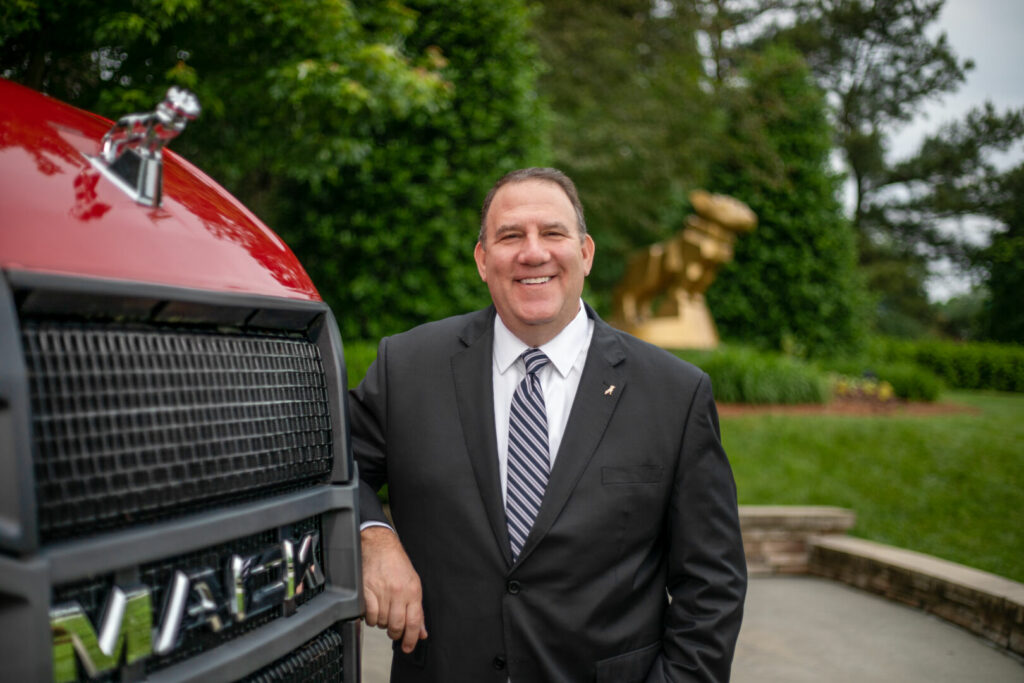Mack Trucks bulldogs following a green path
The color of the bulldog that serves as a Mack Trucks hood ornament is a telling thing. The gold versions sit atop proprietary powertrains. The black ones are linked to limited-edition Mack Anthems. But the copper versions, introduced in 2019, could be described as the ones looking into the future.
They’re the ones that signify electric powertrains.
Alternative energy sources are clearly part of the business plan for the manufacturer. By the end of the decade, each of its truck models is to come with a battery-electric or zero-emission power option.

“We believe in the zero-emissions path, so we’re going to pursue that in a really big way,” said Jonathan Randall, president of Mack Trucks North America, a role he assumed in December after a tenure as senior vice-president – North American sales.
The path still has its challenges, though.
“You’re looking at no less than 12 but probably more like 18 to 24 months to get the [charging] infrastructure in place in a depot in which you tend to deploy fully electric,” he said during an interview with TruckNews.com at ACT Expo. “So you’ve got to start your planning now, in order to make that happen.”
An evolving focus
Fleet planning won’t end there. An evolving focus on operations and scheduling could help manage the number of chargers that are even needed. Quiet battery-electric refuse trucks could be allowed to run earlier and later in the day, Randall offered as an example. Maybe the one on an early shift could share the same charger as a truck that runs later.
“It’s not just buying electric trucks. It’s not just buying chargers. It’s [looking at] the actual operations and the efficiencies, the operations.”
OEMs have their own part to play in the electric evolution, of course. Initiatives such as Volvo Group’s investment in a charging corridor along I-5 offer an example of that. It has also secured partnerships with developers of four charging systems.
Mack also continues to draw lessons from the early LR Electric refuse trucks it has in service.
There haven’t been too many surprises, Randall said, referring to the way waste trucks and their predictable routes are a perfect fit for electrification. “You’ve got to be able to go 100 miles, you’ve got to be able to pick up 1,200 times, and you’ve got to be able to carry 10 tons.” The stop-and-go service offers plenty of opportunities for regenerative braking, too.
Medium-duty electric models
But refuse trucks aren’t the only operations with predictable, return-to-base operations. That’s where Mack’s plans for its MD Electric – launched this spring — come into play, supporting things like 24-foot box trucks with 2,500-pound tuck-under lift gates.
“You know the routes. Pretty much you know the circumference in which you’re operating. You know that they’re home to the same place pretty much every night for charging and maintenance and other stuff,” Randall said. “The medium-duty is a natural for fully electric.”
One such truck being delivered to a customer for a pilot project will have a lift gate that will be charged by solar panels on the roof. And Mack is interested in the results. “We want to know how that performs,” Randall said. If the lift gate needs to cycle 100 times, will that offer enough power? And how much weight will the system add to the vehicle?
Vocational trucks represent another challenge, as engineers look for ways to power things like cement mixers. “Do we have the solution today?” Randall said. “No, but we’re certainly working on it.”
Beyond electric trucks
Mack’s journey to slash emissions is not limited to battery-electric technologies, either. One of its most recent product announcements was a Granite powered by compressed natural gas (CNG) – an option for refuse customers looking to burn a cleaner fuel, such as the gas that be produced from waste.
“It’s still a viable fuel. It’s still a clean fuel,” Randall stressed. “The waste industry is still very heavily invested in CNG.”
The sector has already established the fueling infrastructure, he added. And the same infrastructure can carry renewable natural gas (RNG) in the mix.
As for longhaul applications, one of the answers could lie in hydrogen. Mack’s Volvo Group parent, for example, has partnered with Daimler Truck to co-develop fuel cells under the cellcentric venture.
Then there’s diesel. Investments in the traditional fuel continue as the industry approaches deadlines for reduced emissions from NOx levels to greenhouse gases.
“We’re going to play in both those camps, because we have to,” Randall said. “We’re going to drive the diesel business and continue to meet whatever regulations come out.”
Have your say
This is a moderated forum. Comments will no longer be published unless they are accompanied by a first and last name and a verifiable email address. (Today's Trucking will not publish or share the email address.) Profane language and content deemed to be libelous, racist, or threatening in nature will not be published under any circumstances.